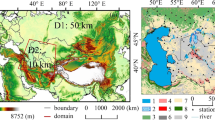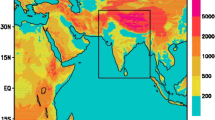Abstract
This study explores the impacts of the desiccation of the Aral Sea and large-scale climate change on the regional climate of Central Asia in the post-1960 era. A series of climate downscaling experiments for the 1960’s and 2000’s decades were performed using the Weather Research and Forecast model at 12-km horizontal resolution. To quantify the impacts of the changing surface boundary condition, a set of simulations with an identical lateral boundary condition but different extents of the Aral Sea were performed. It was found that the desiccation of the Aral Sea leads to more snow (and less rain) as desiccated winter surface is relatively much colder than water surface. In summer, desiccation led to substantial warming over the Aral Sea. These impacts were largely confined to within the area covered by the former Aral Sea and its immediate vicinity, although desiccation of the Sea also led to minor cooling over the greater Central Asia in winter. A contrasting set of simulations with an identical surface boundary condition but different lateral boundary conditions produced more identifiable changes in regional climate over the greater Central Asia which was characterized by a warming trend in both winter and summer. Simulations also showed that while the desiccation of the Aral Sea has significant impacts on the local climate over the Sea, the climate over the greater Central Asia on inter-decadal time scale was more strongly influenced by the continental or global-scale climate change on that time scale.












Similar content being viewed by others
References
Bortnik, V. N., & Chistyaeva, S. P. (1990). Hydrometeorology and hydrochemistry of the seas of the USSR The Aral Sea (Vol. 7, p. 194). Leningrad: Gidrometeoizdat. (in Russian).
Bukovsky, M. S., & Karoly, D. J. (2009). Precipitation simulations using WRF as a nested regional climate model. Journal of Applied Meteorology and Climatology, 48, 2152–2159.
Caldwell, P. M., Chin, H.-N. S., Bader, D. C., & Bala, G. (2009). Evaluation of a WRF dynamical downscaling simulation over California. Climatic Change, 95, 499–521.
Chub, V. E. (2000). Izmenenie klimata i ego vliyanie na prirodno-resursniy potential Respubliki Uzbekistan. Tashkent: Glavgidromet RUz. (in Russina).
Conry, P., Sharma, A., Fernando, H. J. S., Leo, L. S., Potosnak, M., Hellmann, J. (2014). Multi-scale simulations of climate-change influence on Chicago heat island, FEDSM2014 Paper No. 21581. In: Proceedings of the fourth joint US-European fluids engineering division summer meeting, Chicago, IL, American Society of Mechanical Engineers, FEDSM2014-21581.
Conry, P., Sharma, A., Fernando, H. J. S., Leo, L. S., Potosnak, M., & Hellmann, J. (2015). Chicago’s heat island and climate change: Bridging the scales via dynamical downscaling. Journal of Applied Meteorology and Climatology, 54(7), 1430–1448.
Duliere, V., Zhang, Y., & Salathe, E. P., Jr. (2011). Extreme precipitation and temperature over the U.S. Pacific Northwest: A comparison between observations, reanalysis data, and regional models. Journal of Climate, 24, 1950–1964.
Giorgi, F., et al. (2001). Emerging patterns of simulated regional climatic changes for the 21st century due to anthropogenic forcings. Geophysical Research Letters, 28, 3317–3320.
Heikkilä, U., Sandvik, A., & Sorteberg, A. (2011). Dynamical downscaling of ERA-40 in complex terrain using the WRF regional climate model. Climate Dynamics, 37, 1551–1564.
Kain, J. S. (2004). The Kain-Fritsch convective parameterization: An update. Journal of Applied Meteorology, 43, 170–181.
Kalnay, E., et al. (1996). The NCEP/NCAR 40-year reanalysis project. Bulletin of the American meteorological Society, 77, 437–471.
Khan, V. M., & Holko, L. (2009). Snow cover characteristics in the Aral Sea basin from different data sources and their relation with river runoff. Journal of Marine Systems, 76, 254–262. doi:10.1016/j.marsys.2008.03.012.
Khan, V. M., Vilfand, R. M., & Zavialov, P. O. (2004). Long-term variability of air temperature in the Aral Sea region. Journal of Marine Systems, 47, 25–33.
Kistler, R., Kalnay, E., Collins, W., Saha, S., White, G., Woollen, J., et al. (2001). The NCEP-NCAR 50-year reanalysis: Monthly means CD-ROM and documentation. Bulletin of the American meteorological Society, 82, 247–267.
Kulkarni, P. S., Dasari, H. P., Sharma, A., Bortoli, D., Salgado, R., & Silva, A. M. (2016). Nocturnal surface ozone enhancement over Portugal: Influence of different atmospheric conditions. Atmospheric Environment. doi:10.1016/j.atmosenv.2016.09.056.
Leung, L. R., & Qian, Y. (2003). The sensitivity of precipitation and snowpack simulations to model resolution via nesting in regions of complex Terrain. Journal of Hydrometeorology, 4, 1025–1043.
Lioubimtseva, E. (2015). A multi-scale assessment of human vulnerability to climate change in the Aral Sea Basin. Environmental Earth Sciences, 73(2), 719–729.
Lo, J. C. F., Yang, Z. L., & Pielke, R. A. (2008). Assessment of three dynamical climate downscaling methods using the Weather Research and Forecasting (WRF) model. Journal of Geophysical Research, 113, D09112. doi:10.1029/2007JD009216.
Muminov, F. A., & Inagatova, I. I. (1995). Variability of Central Asian climate (p. 15). Tashkent: SANIGMI. (in Russian).
Perera, J. (1993). A sea turns to dust. New Scientist, 23, 24–27.
Raucher, S., Coppola, E., Piana, C., & Giorgi, F. (2010). Resolution effects on regional climate model simulations of seasonal precipitation over Europe. Climate Dynamics, 35, 685–711.
Rockel, B., Castro, C. L., Pielke, R. A., von Storch, H., & Leoncini, G. (2008). Dynamical downscaling: Assessment of model system dependent retained and added variability for two different regional climate models. Journal of Geophysical Research, 113, D21107. doi:10.1029/2007JD009461.
Roy, S. B., Smith, M., Morris, L., Orlovsky, N., & Khalilov, A. (2014). Impact of the desiccation of the Aral Sea on summertime surface air temperatures. Journal of Arid Environments, 110, 79–85.
Sharma, A., Fernando, H. J., Hellmann, J., Chen, F. (2014). Sensitivity of WRF model to urban parameterizations, with applications to Chicago metropolitan urban heat island. In: ASME 2014 Fourth Joint US-European Fluids Engineering Division Summer Meeting, American Society of Mechanical Engineers, V01DT28A002.
Sharma, A., Conry, P., Fernando, H. J. S., Hamlet, A. F., Hellmann, J. J., & Chen, F. (2016). Green and cool roofs to combat urban heating in Chicago: Evaluation with WRF regional climate model. Environmental Research Letters, 11, 064004. doi:10.1088/1748-9326/11/6/064004.
Sharma, A., Fernando, H. J. S., Hamlet, A. F., Hellmann, J. J., Barlage, M., & Chen, F. (2017). Urban meteorological modeling using WRF: A sensitivity study. International Journal of Climatology. doi:10.1002/joc.4819.
Sharma, A., & Huang, H.-P. (2012). Regional climate simulation for Arizona: Impact of resolution on precipitation. Advances of Meteorology, 2012, 13. doi:10.1155/2012/505726. (Art. ID 505726).
Skamarock, W. C., et al. (2008). A description of the advanced research WRF version 3. NCAR Tech., Note NCAR/TN-4751STR, p. 113.
Small, E. E., Giorgi, F., Sloan, L. C., & Hostetler, S. (2001). The effects of desiccation and climatic change on the hydrology of the Aral Sea. Journal of Climate, 14, 300–322.
Solomon, S., et al. (Eds.) (2007). Climate change 2007—Physical science basis: contribution of working group I to the fourth assessment of the IPCC (p. 1009). Cambridge University Press, Cambridge.
Talbot, C., Bou-Zeid, E., & Smith, J. (2012). Nested mesoscale large-eddy simulations with WRF: Performance in real test cases. Journal of Hydrometeorology, 13, 1421–1441.
Urrutia, R., & Vuille, M. (2009). Climate change projections for the tropical Andes using a regional climate model: temperature and precipitation simulations for the end of teh 21st century. Journal of Geophysical Research. doi:10.1029/2008JD011021.
Xi, X., & Sokolik, I. N. (2016). Quantifying the anthropogenic dust emission from agricultural land use and desiccation of the Aral Sea in Central Asia. Journal of Geophysical Research: Atmospheres, 121(20), 12270–12281. doi:10.1002/2016JD025556.
Zavialov, P. O. (2005). Physical oceanography of the dying Aral Sea (p. 146). Berlin: Springer.
Zavialov, P. O., (2010). Physical oceanography of the Large Aral Sea. In A. G. Kostianoy & A. N. Kosarev (Eds.) Aral sea environment. The Handbook of Environmental Chemistry (pp. 123–146). Springer, Berlin. doi:10.1007/698_2009_4.
Zavialov, P., & Huang, H. P. (2013). Desiccation of the Aral Sea and climate change in Central Asia: Interplay and mutual feedbacks. In EGU General Assembly Conference Abstracts (vol. 15, p. 8776).
Acknowledgements
The authors acknowledge the support by U.S. CRDF. Sharma and Huang also acknowledge the support by NSF Grant AGS-0934592.
Author information
Authors and Affiliations
Corresponding author
Electronic supplementary material
Below is the link to the electronic supplementary material.
Rights and permissions
About this article
Cite this article
Sharma, A., Huang, HP., Zavialov, P. et al. Impact of Desiccation of Aral Sea on the Regional Climate of Central Asia Using WRF Model. Pure Appl. Geophys. 175, 465–478 (2018). https://doi.org/10.1007/s00024-017-1675-y
Received:
Revised:
Accepted:
Published:
Issue Date:
DOI: https://doi.org/10.1007/s00024-017-1675-y




